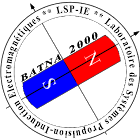Publication Internationale
, “A novel combined MPPT-pitch angle control for wide range variable speed wind turbine based on neural network,” International Journal of Hydrogen Energy, vol. 41 N 22, pp. 9427-9442, 2016.Abstract
, “PMSM Model with Phase-to-Phase Short-Circuit and Diagnosis by ESA and EPVA,” Advances in Electrical and Electronic Engineering, vol. 14 N 5, pp. 522-530, 2016.Abstract
, “Electromagnetic Field Computation in Linear Electromagnetic Actuators Using the Meshless Local Petrov Galerkin Method,” Acta Electrotechnica et Informatica, vol. 16, no. 01 January - March 2016, 2016.
, “On-Line Efficiency Improvement of Induction Motor Vector Controlled,” Advances in Electrical and Electronic Engineering journal, vol. 14, no. 3, 2016.
, “Sensorless Fault-Tolerant Control of an Induction Motor Based Electric Vehicle,” Journal of Electrical Engineering & Technology JEET, JEET, vol. 11, no. 5, pp. 1423-1432, 2016.
, “Backstepping design for fault detection and FTC of an induction motor drives-based EVs,” Automatika – Journal for Control, Measurement, Electronics, Computing and Communications, vol. 57, no. 3, pp. 736–748, 2016.
, “Optimized Torque Control via Backstepping Using Genetic Algorithm of Induction Motor,” Automatika – Journal for Control, Measurement, Electronics, Computing and Communications , vol. 57, no. 2, pp. 579–592, 2016.
, “Robust Backstepping MPPT for Photovoltaic System,” International Journal of Chem Tech Research :IJCRGG, 2016.
, “TS Fuzzy Logic-Based Rotor Resistance Tuning in case of Induction Machine Vector Control,” Automatika-Journal for Control, Measurement, Electronics, Computing and Communications, vol. 56, N°.4, pp. 454–465, 2015.
, “Fuzzy speed estimation in case of sensorless induction machine vector control ,” Turkish Journal of Electrical Engineering & Computer Sciences, 2015.
, “Effective Fuzzy Logic Control of a Stand-alone Photovoltaic Pumping System,” the Journal of Renewable Energy Research, vol. 5, No.3, 2015.Abstract
, “Dynamic control and advanced load management of a stand-alone hybrid renewable power system for remote housing,” Energy Conversion and Management, Elsiver, vol. 105, no. 15, 2015.
, “A developed energy management strategy for a stand-alone hybrid power system for medium rural health building,” International Transactions On Electrical Energy Systems Int. Trans. Electr. Energ. Syst. (2015), vol. 26(4), 2015. Publisher's VersionAbstract
, “Implementation of a New MRAS Speed Sensorless Vector Control of Induction Machine,” IEEE Transactions On Energy Conversion, vol. 30 No. 2, no. No. 2, pp. 588-595, 2015.
